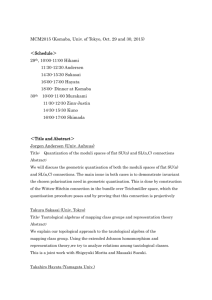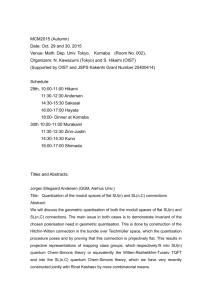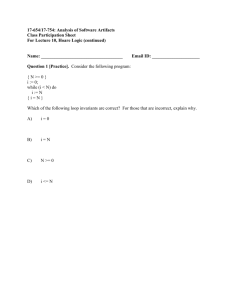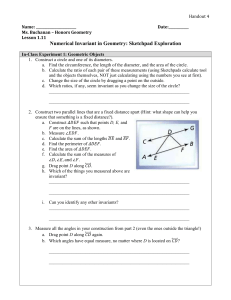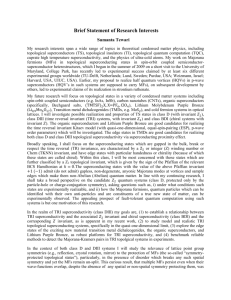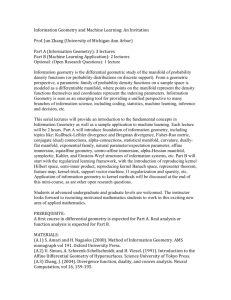Informal note on Topology, Geometry and Topological Field Theory
advertisement
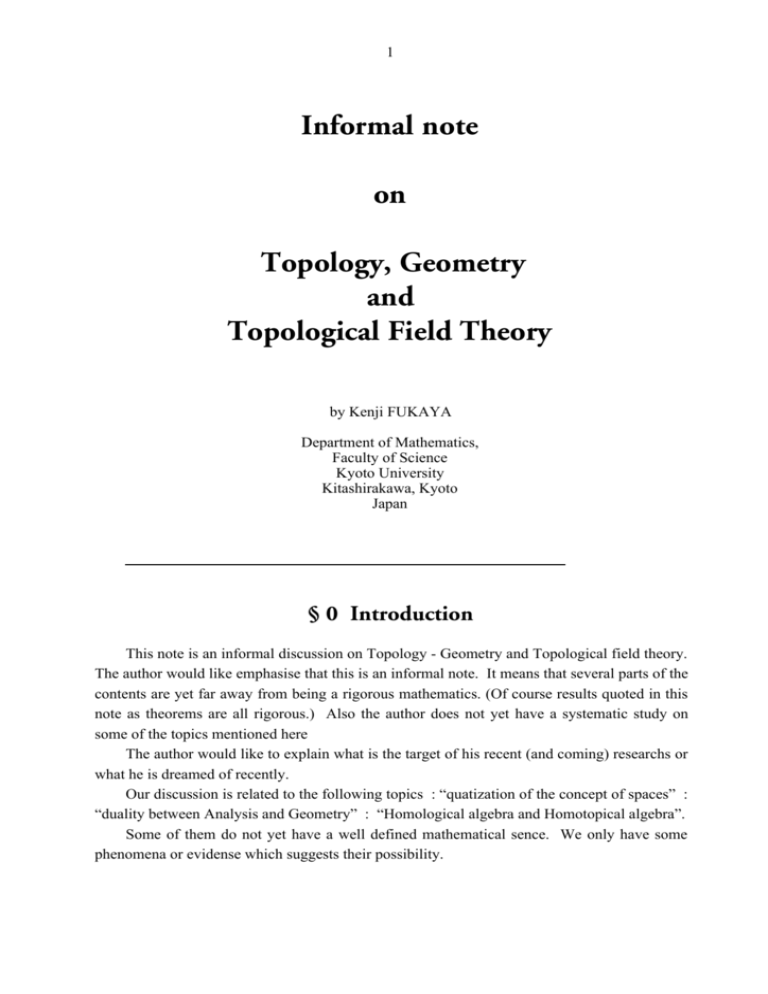
1
Informal note
on
Topology, Geometry
and
Topological Field Theory
by Kenji FUKAYA
Department of Mathematics,
Faculty of Science
Kyoto University
Kitashirakawa, Kyoto
Japan
§ 0 Introduction
This note is an informal discussion on Topology - Geometry and Topological field theory.
The author would like emphasise that this is an informal note. It means that several parts of the
contents are yet far away from being a rigorous mathematics. (Of course results quoted in this
note as theorems are all rigorous.) Also the author does not yet have a systematic study on
some of the topics mentioned here
The author would like to explain what is the target of his recent (and coming) researchs or
what he is dreamed of recently.
Our discussion is related to the following topics : “quatization of the concept of spaces” :
“duality between Analysis and Geometry” : “Homological algebra and Homotopical algebra”.
Some of them do not yet have a well defined mathematical sence. We only have some
phenomena or evidense which suggests their possibility.
2
§ 1 Duality between Geometry and Analysis
Let us start from the following “definition”.
“Definition” 1.11 Let M be a space.
A geometry of M is studying a map from another space Y to M .
An analysis on M is studying a map from M to another space Y .
Example 1.2
Let M = R 2 be the Euclidean plane. Then usual Euclidean geometry is
studying lines, triangles, circles etc. They are maps from S1 or R to M = R 2 .
The analysis on M = R 2 is the study of functions of two variables f (x,y), and so is the
study of maps from M = R 2 to R .
From this “definition” it is quite clear what the author mean by “Gemetry is dual to
Analysis”. Of course everything is well known in Example 1.2. Let us mention less obvious
exapmles.
The first example is well known De-Rham’s theorem. Here :
[Geometry] The singular or simplicial homology theory Hk (M) is defined by considering
cycles, that is studying maps ∆ → M from a simplex ∆ to M .
De-Rham cohomology is described by Λk (M) , the set of all k forms, and the
ker d k
k
k
k +1
k
homomorphism d : Λ → Λ . Namely HDr (M) =
.
Im d k −1
[Analysis]
De-Rham’s theorem implies that Hom( Hk (M),R ) ≅ H kDr (M) , the duality between geometry
and analysis. We remark that this duality is basic in electro magnetism, that is the abelian
gauge theory. We go back to this example in § 3.
Let me mention examples discovered more recently . That is related to the scaler curvature.
There is basically two methods are known to study manifold of positive scaler curvature. One
is minimal surface theory and the other is Dirac operator. I only mention small parts of them.
[Geometry] Minimal surface theory. Let M be a 3 manifold of positive scaler curvature. A
theorem by D.Fisher-Coblbrie, R.Schoen and S.Yau says that if Σ → M is a (stable) minimal
surface, then Σ is diffeomorphc to S 2 . Using also existence result of minimal surface in a
given homotopy class, we obtain a topological constraint of M .
Analysis:
Let M be an even dimensional spin manifold. We then have a bundles of
positive and negative spinors S + , S − . Using Riemannian metric we have an elliptic operator
D: S + → S − , the Dirac operator. A theorem of Lichnerowitz implies that, if the Scaler
1
M. Gromov mentioned this kind “Definition” in his talk at meeting of Japan Mathematical Society. He is not
responsible to any nonsence in this note.
3
curvature of M is positive then kernel and cokernel of Dirac operator vanishes. On the other
hand, the Atiyah-Singer index theorem implies that dim ker D − dim coker K is a topological
invariant of M , described explicitely by characteristic classes of M . Joining them we obtain
a topological constraint of manifold of positive scaler curvature.
Thus Minimal surface and Dirac operator are the two basic methods to study manifolds of
positive curvature. And, in fact, they imply the same result sometime, but by a different proof.
It seems that there is no good explanation of the relation between these two methods. They are
dual in our sence.
Problem 1.3
Find a more mathematical way to describe the duality between minimal
surface and Dirac operator.
There is a similar phenomena related to positive mass conjecture.
The next example is a mirror symmetry. I can not discribe it precisely, partly because I
do not have a enough knowledge on what is going on the study of Mirror symmetry, and partly
because the problem is yet widely open.
Geometry: Let M be a 3 dimensional Kähler manifold. Assume the Ricci curvature of M
vanishes. We consider the space
{
}
M k (M) = ϕ : S2 → M Jϕ = ϕJ, ϕ *[ω] ∩ [S2 ] = k
Here ω is a Kähler form on M and J are complex structures of M and S 2 . By the
assumption on Ricci curvature, the virtual dimension of this space is independent of k and is
equal to 0. By counting its order we obtain some numbers. This construction can be generalized
to give a quantum deformation of cup product.
Analysis:
Let M be as above. We consider the sheaf cohomology H1(M;O(T )). Here
O(T ) is the sheaf of holomorphic sections of tangent bundles. This cohomology is given by
harmonic
theory.
There
is
a
cubic
map
called
Yukawa
coupling
1
1
1
H (M;O(T )) ⊗ H (M;O(T)) ⊗ H (M;O(T )) → C .
The mirror conjecture asserts that the Geometry of M in the above sence is equivalent to
Analysis of Mˆ . Here Mˆ is another Ricci flat Kähler 3 fold which is called the Mirror of M .
Our fourth example is a theorem proved recently by C. Taubes [T] . Let (M,ω ) be a
symplectic 4 manifold.
Geometry: (Gromov-Witten invariant). We fix an almost complex structure J on M
compatible with the symplectic structure of M . Namely we assume that g(X,Y) = ω(JX,Y)
is a Riemannian metric. Let x ∈H 2 (M;Z ). Let Σ g be the closed surface of genus g . We
put
4
M g (M, x) =
{ϕ :(Σ
g
, JΣ) → M Jϕ =ϕJ Σ, ϕ*[ω ] =PD ( x)
~
}
Here PD is the Poincare duality and (ϕ, JΣ ) ~ (ϕ ′, J ′Σ ) if and only if there exists a
diffeomorphism ψ : Σ g → Σ g such that (ϕ, JΣ ) = (ϕ ′ψ ,ψ * JΣ′ ) . By Riemann-Roch’s theorem,
one can find the virtual dimention of M g (M, x) . We consider the order of this set M g (M, x)
counted with sign when the dimension is 0. This is by definition the Gromov-Witten invariant
ZGW (M,x) . (g is automatically determined.)
Analysis:
(Seiberg-Witten invariant) Let x ∈H 2 (M;Z ) and L be a complex line bundle
such that c1 (L) = x . We consider SpinC structure P of M such that L = P × SpinC( 4 ) U(1) .
The group
SpinC (4) has (complex 2 dimensional) representations
∆± . We put
S ± = P ×SpinC (4) ∆± .
Given a connection
A
on
L there is a Dirac operator
DA : Γ(S+ ) → Γ(S − ). Also there is a quadratic map Φ : Γ(S + ) → Γ(Λ+2 (M)) , where Λ+2 (M)
is the bundle of self-adjoint 2 forms. The Monopole moduli space is defined by
{(A,u )
DA u =0, Φ(u) =dA + ∗dA }
G
.
Here G is the Gauge group Aut(L) = Map(M,U(1)) . Counting the order of this moduli space
(with sign), when its virtual dimension is 0, we get the Seiberg -Witten invariant. ZSW (x) .
Taubes’ theorem assert ZGW (M,x) = ZSW (x) .
Remark 1.4 The above therem by Taubes seems to be closely related to Problem 1.3. Namely
the Seiberg-Witten invariant is defined by using monopole equation which is a nonlinear
version of Dirac operator. Also Seiberg- Witten invariant is closely related to scaler curvature.
On the other hand, Gromov-Witten invariant is defined by using pseudo holomorphic curve
equation. Holomorphic curve is a minimal surface. And Witten [W2] means that Gromov-Witten
invariant is the twisted and topological version of the minimal surface theory (or harmonic
map).
Now let M be a manifold. We consider C(M) , the space of all functions on M . The
basic idea of noncommutative geometry by A.Connes and others is to consider noncomutative
ring instead of the commutative ring C(M) . In our terminology, this can be regarded as an
“analytic approach” to generalize the concept of spaces.
Problem 1.5 Are there any “geometric approach” which is dual to noncommutative geometry
?
Probably there is already an answer, that is the String theory. Let me remark that
generalization of the concepts of spaces is the basic problem to quatize the gravity, and string
5
theory is regarded as a good candidate of quatum gravity.
§ 2 Topological field theory
and
homologycal-homotopical algebra
It seems to me that the idea of String theory to generalize the concept of space is as
follows. Let M be a space. We consider the space of maps Map(Σ, M) , from surface Σ to
M . We consider an “integral”
⌠ e L( f )Df
⌡f
(2.1)
Here Df is the “Feynmann measure”, and L( f ) is a Lagrangian, a function on Map(Σ, M) ,
which we do not specify. The integral is taken over the space Map(Σ, M) or its submanifold.
L( f ) may depend also on additional structures on M and Σ , for example vector bundle
on M , submanifold of M or Σ etc. By chaning such additional structures on M or Σ
and also the topological type of Σ (the genus of Σ ), we obtain a system of numbers. (We fix
topology and geometry of M .) We regard them as “correlation function of 2 dimensional
field theory”. This field theory is two dimensional, since (in our terminology) we are discussing
analysis on Σ .
Thus if we could justify (2.1) for appropriate L( f ), we would get a “functor”
(2.2)
{Spaces} ⇒ {2 dimensional field theories} .
Here the author does not know the definitino of “the category of 2 dimensional field theory”,
because that is exactly the target of the research, which seems very hard and take a lot of time.
Conjecture 2.1
The functor is locally injective. Namely there is no deformation of spaces
which gives the same field theory.
If this conjecture is true , then one may say that “2 dimensional field theory” is a generalization
of the concept of spaces .
However it seems still too much difficult at this point to attack this kind of problems and
to make these constructions mathematically rigorous. So instead of studying Geometry we
start with Topology, which is somewhat easier. The schema is
Geometry
Topology
⇔
⇔
(Actual) Field theory
Topological Field theory
6
More precisely, the functor {metric spaces} ⇒ {2 dimensional field theories} , is an (actual)
Field theory. And {topological spaces} ⇒ {2 dimensional field theories} is a topological field
theory.
Now we consider the problem, what is the definition of “2 dimensional field theory” we
need for this purpose. The author believe that answering this question is exactly the algebraic
topology. To explain why, let us recall what was the basic idea of algebraic topology.
We, for a moment, give up to replace all informations of topological spaces by algebras
and try to replace spaces as much as possible by algebras. Namely our purpose here is to
approximate spaces by algebras. The first step is :
Example 2.2
.
The homology theory is to approximate the space by chain complex C* (X)
Thus the strategy to generalize the concepts of the space is as follows. First replace the
space (manifold) by algebraic objects as much as possible. Then generalize these algebraic
objects.
Remark 2.3
This approach is, in fact, not so much satisfactory, since what we are
looking for is a geometric (not algebraic) notion generalizing the concept of spaces. But this is
the only approach I can try for a moment.
Remark 2.4
We again recall that there is one established way to replace space by
algebra. That is to replace the space X by C(X) the ring of functions. But as we
mentioned, this is analytic approach. What we are looking for is an approach dual to this one.
The next step to approximat space by its (co) homology is to involve cup product and
those kinds of product structure. In the analytic way, this was achieved by De-Rham homotopy
theory or rational homotopy theory by D. Quillen - D. Sullivan. We recall
Definition 2.5
Two simply connected spaces M and M ′ are said to be Q homotopy
equivalent if there exists N and maps f : N → M , f ′ : N → M ′ such that f and f ′
induce isomorphism on homotopy groups ⊗Q .
Roghly (and inprecisely) speaking, two spaces are Q homotopy equivalent, if and only if
“they are homotopy equivalent up to finite ambiguity” .
The idea of rational homotopy theory is to approximate space by differential graded
algebra (DGA) , the cochain complex with product structure. This is performed by using
differential forms. We recall
Definition 2.6
(Λk ,d,⋅) is said to be a differential graded algebra (DGA) if. (Λk ,⋅) is a
graded ring satisfying graded commutativity.
Namely
Λk ⋅ Λk ′ ⊆ Λk+ k ′ ,
a ⋅ b = −(−1) deg a deg b b ⋅ a . Here deg a = k if a ∈Λk . (Λk ,d) is a chain complex (that is
7
d : Λk → Λk+ 1 , dd = 0 .) Finally d is a differential that is d(a ⋅ b) = da ⋅ b + (−1)deg a a ⋅ db.
Let M be a manifold. Then the ring of differential forms (Λk (M),d, ∧) is a DGA.
Thus we have a functor
{manifolds} → {DGA}
(2.7)
Remark 2.8
In fact, the DGA (Λk (M),d, ∧) itself does not work well for this construction,
since it is not finitely generated and too big. Sullivan’s idea in [Su], is to triangulate the
manifold and use piecewise linear form with rational coefficient. We do not discuss this point
here.
Then in inprecise way, the result by D.Quillen and D.Sullivan is described as
“Theorem” 2.9
The functor induces an isomorphism
{spaces}
homotopy equivalent
≅
{DGA}
homotopy equivalent
Remark 2.10
I put “” in Theorem 2.9 only because the way written here is not precise.
The theorem is rigorously established in their papers.
Again this is analytic approach, since it uses differential form. What is dual and geometric
approach to it. ? It is to consider tree and maps from it. Here we recall
Definition 2.11
A simplicial complex T if it is one dimensional and simply connected.
(See Table 1 for example.) Then dual in “Geometry” to the construction of DGA is as follows
: dim Σ = 1 Consider the space of maps Map(T,M) from a tree to M .
: dim Σ = 2 Consider the space of maps Map(S2 , M) from a Riemann sphere with marked
points to M .
These ideas are discussed in more detail in [Fu1], [Fu2], so we do not repeart it here.
Here are tables describing main ideas of this note.
8
§ 3 Degree, Linking number
and Vassiliev invariant
To mention something more down to earch, we recall here the work by Gauss, Vassiliev,
Bar-Nathan, Kontsevitch, Bott-Taubes, D.Thurston etc. In this section, we follow Bott-Taubes’
paper [BT] and D.Thurston’s lecture [Th] in many points.
Let us first consider the mapping degree of a map f : M n → N n between two closed
oriented manifolds of the same dimension. There are two simple ways to define it :
(3.1.1)
Let p ∈N be the regular value of f . Then f −1(p) consists of finitely many
points. For each q ∈ f − 1(p) , we consider the differential Dfq : Tq M → Tp N of f . We put
ε q = 1 if Dfq preseaves orientation and ε q = −1 if not. The mapping degree of f is then
deg f = ∑ ε q .
q ∈f −1( p )
(3.1.2)
We choose any n -form ω on N such that ⌠ ω ≠ 0 . Then mapping degree
⌡N
of f is equal to deg f = ∫M
∫N
f *ω
ω
.
In our terminology (3.1.1) is a geometric way and (3.1.2) is an analytic way to define
mapping degree. Their coincidence is a consequence of De-Rham’s theorem.
To unify two definition one cay use (as De-Rham did) the notion of current. We recall
that a k current T on an n dimensional manifold M is a map T : Λn −k (M) → R , which is
R -linear and is continuous with respect to the C ∞ -topology. k form ω is regarded as a k
current Tω by Tω (v) = ∫M ω ∧ v . An oriented n − k dimensional submanifold N is
regarded as a k current TN by TN (v) = ∫ N v .
Using current we can rewrite (3.1.1) as deg f = ∫M
∫N
f *Tp
Tp
. In this way the description is
completely parallel to (3.1.2). We remark that the pull back of the current f *T is not always
well defined. In fact in the case T = TN for a submanifold N , the pull back f *T is well
defined if and only if f is transversal to N . This is the condition we assumed in (3.1.1).
Now we use this exercise to study Gauss’ formula for linking number. Let ω S2 be the
volume element of S 2 such that
∫S
2
(
G(x, y) =
Here ∆ stands for the diagonal.
Lemma 3.2 d G*ω S2 = T∆ .
(
)
)
ω s2 = 1. We conisider a map G : R 3 × R 3 ( ∆ → S 2 by
x−y
.
x−y
9
Proof:
Of course this is well known and very old lemma (probably goes back to Gauss.)
But the author wants to prove it since the proof suggests the relation of the lemma to the
compactification of configuration space due to Fulton-Macphearson [FM] and Kontsevitch
[Ko1].
First we “complactify”
R3 × R3 ( ∆
as follows.
We take direct product
((R
3
) )
(
×R (∆ ×S
3
(
)
)
((
) )
and a map R × R ( ∆ → R 3 × R 3 ( ∆ × S 2 , (x, y) → ((x, y),G(x, y)).
2
3
3
(
)
The closure of the image of this map is a manifold with boundary. We write it R 3 × R 3 ( ∆ .
(
(
)
G : R3 × R3 ( ∆ → S2
Obviously
)
(
is extended to
)
(R
3
)
× R3 ( ∆ .
The boundary
∂ R 3 × R 3 ( ∆ of R 3 × R 3 ( ∆ is identified to the unit sphere bundle S(R 3 ) of the tangent
3
bundle of R .
Now let v ∈Λ3 (R 3 × R 3 ) be the arbitrary test function. Using, Stokes’ theorem, we
calculate
(dG T )(v)
*
ωS 2
=⌠
dv ∧ G*ω S2
⌡( R3 × R 3) ( ∆
=⌠
dv ∧G *ω S2
3
3
⌡( R ×R )( ∆
(
⌠
=
d v ∧ G *ω S2
3
3
⌡( R ×R )( ∆
)
−⌠
v ∧ dG *ω S 2
⌡( R 3 ×R 3 )( ∆
=⌠
v ∧G *ωS2
⌡∂ ( R3 ×R 3)( ∆
=⌠ v
⌡∆
The lemma follows.
Now let l i : S1 → R ( i =1,2 ) be the link, that is we assume that they are embeddings
and that the images are disjoint to each other. We then obtain a map Φ : S1 × S1 → S2 by
Φ(s,t) = G(l1 (s),l 2 (t)) . The linking number of this link is by definition is the degree of this
map. They are calculated by two different ways :
(3.3.1)
We consider a generic point p ∈S 2 and count the order of the set Φ −1 (p) with
sign. (See (3.1.1) for the way to define sign.)
(3.3.2)
We calculate the integral
∫
S2
Φ *ω s2 .
They give the same number. It implies the famous formula by Gauss :
10
1
1
⌠ ⌠
Lk(l1,l2 ) =
⌡0 ⌡0
(3.4)
(( l (s) − l (s)) × ) •
1
2
dl1
ds
3
l1(s) − l 2 (s)
dl2
dt
dsdt
It is easy to see that (3.3.2) gives the right hand side of (3.4). To see that 3.3.1 gives the
left hand side, we remark the following two facts.
(a)
If (l1(s),l2 (t)) is unlink, we can put one of them in the region x >> 0 ,
y , z <1 , and the other in x << 0 , y , z <1 . It is then easy to see that 3.3.1 is zero in that case.
(b)
We study how many the number in 3.3.1 changes when l1 cross l 2 and go
other side. It is easy to see by geometric observation that it changes by ±1 .
Combining these two observation we are done.
Remark 3.5 There is third choice for the current representing the fundamental class of S 2 .
Namely we take S1 ⊆ S 2 , and consider the current dα ∧ TS1 . Here α : S1 → R Z is the
diffeomorphism. Using this current we obtain a formula similar to Kontsevitch integral (See
[Ba2] ) to give linking number. (This is pointed out by D.Thurston and D.Bar-Nathan in [Th].)
So far everything yet is classical and well known. But this formalism can be generalized
directly to study Vassiliev invariant. Let l :S1 → R 3 be a knot. Following Bott-Taubes we
put
{
}
C4 = (t1,t2 ,t3,t 4 ) ∈ (S1 ) t1,t2 ,t3,t 4 respects the cyclic order .
4
We have a map Φ 4 : C4 → ( S 2 ) , (t1,t2 ,t3 ,t4 ) a ( G(l(t1),l(t3 )),G(l(t2 ),l(t4 ))) . Unfortunately
the space C4 has a boundary. Hence the mapping degree of Φ 4 is not well defined. One
take the following
2
t1,t2 ,t 3 respects the cyclic order
3
C3, 1 = (t1 ,t2 ,t3 ,x) ∈ (S1 ) × R 3
x ≠ l(t1 ),l(t2 ),l(t3 )
We then have a map Φ 3, 1 : C3,1 → ( S2 ) , (t1,t2 ,t3 , x) a (G(l(t1 ),x),G(l(t2 ), x),G(l(t3 ), x)) . BottTaubes proved that the combining them one get a well defined a degree. (Their approach is
based on De-Rham theory. D. Thurston gave a version of counting number of the inverse of
one point. )
They use a compactification of the configulation spaces C4 , C3, 1. Those compactification
3
(
)
is a generalization of R 3 × R 3 ( ∆ discussed in the proof of Lemma 3.2.
We mention the relation of this construction to graph. The configulation space C4 is
related to the graph 1 and C3, 1 is related to graph 2 below.
11
Figure 2
Figure 1
§4 Invariant of 3 manifolds
and
Morse homotopy
We want to generalization the construction of the last section to general 3 manifolds.
Maybe the most direct generalization is as follows. We assume that our 3 manifold M is a
homology 3 sphere. We fix a frame of M , that is a trivialization of the tangent bundle TM .
We fix a point p of M and put M o = M({p}.
Lemma 4.1 There exists a map G : M o × M o ( ∆ → S 2 which extends to a map from
M o × Mo ( ∆ to S 2 such that its restriction to ∂ M o × M o ( ∆ = SM o is obtained by the given
framing of TM .
(
)
Here M o × Mo ( ∆ is defined in a similar way as R 3 × R 3 ( ∆ . The proof of Lemma 4.1
is an easy obstruction theory. However in fact we need some more condition on the behavior
of the map G : M o × M o ( ∆ → S 2 at the neighborhood of infinity of M o . (Namely in the
neighborhood of the point p of M . )
We consider the 2 form G*ω S 2 on M o × Mo ( ∆ . In a way similar to Lemma 3.2 we can
(
)
prove d G*ω S2 = T∆ . It seems likely that one can obtain an invariant of knot using this form
in a way similar to Bott-Taubes.
Remark 4.2 M.Kontsevitch [Ko1] discussed 3 manifold invariant using 2 form ω on
M o × Mo ( ∆ such that dω = T∆ . Probably the construction of such a form he had in mind is
the one discussed above. The way taken by Axerlod- Singer [AS] is to use Riemannian metric
and Green’s function to find such a form ω on M o × Mo ( ∆ such that dω = T∆ . It is easy to
see that the form obtained above is directly related to the framing of M .
12
To study 3 manifold invariant (instead of knot invariant) using this 2 form, we consider
the following diagram.
Figure 3
It means that we consider the following integral
(4.3)
∫(( x ,y ),( x , y ),(x , y ))∈( M × M ( ∆ )
o
1
1
1
1
1
o
3
ω(x1 ,y1) ∧ω(x2 ,y 2 ) ∧ω(x3, y3 )
1
One need correction term to get well defined invariant. See Axerlod- Singer [AS] , for
detail.
Problem 4.4 Find another version of the way to define the same invariant by counting argument
using the map G : M o × M o ( ∆ → S 2 .
The author [Fu4], found counting argument to define similar (and most likely the same)
invariant, in a bit different way from using the map G : M o × M o ( ∆ → S 2 . This approach is
based on Morse theory and is roughly described as follows. We choose 3 generic functions
f1, f2 , f3 on M . We fix a Riemannian metric on M . And let ϕ tfi be the one parameter
group of transformations associated to the gradient vector field of fi . We use the moduli
space
(4.5)
{
M MS ( f1 , f2 , f3) = (t1 ,t2 ,t 3, x, y) ∈R +3 × M 3 ϕ tfii (x) = y i = 1, 2,3
}
Counting its order we obtain a number. We also need correction term to obtrain a well defined
invariant. We omit the detail which is discussed in [Fu3], [Fu4].
Remark 4.6 It is sometimes simpler to work with local coefficient. Namely we consider a flat
Lie algebra bundle η on M such that H* (M;η) = 0 . This implies that the current T∆
represented by the diagonal in M × M is a boundary in this local coefficient. So we do not
need to remove one point p to find a current ω such that dω = T∆ .
13
Remark 4.7 The graph in Figure 1.3 is regarded as a Feymann diagram. Then, the invariant
we have been discussed is a 2 loop amplitude. There is an interaction in this case. In fact the
interaction is related to the product structure. In Formula 4.3 it is related to the wedge product
of the forms. And in Formula 4.5 it is related to the intersection theory.
Originally E.Guadagnini-M.Martinelli-M.Mintchev, D.Bar-Nathan, Axerlod-Singer, Kontsevitch discovered this kind of construction as a pertubation theory for Chern-Simons Gauge
theory or Witten’s invariant. It is Kontsevitch who obsearved its relation to homotopical
algebra and to compactification of configulation space.
Finally we remark that their is probably a family version of this construction, as is pointed
out by [AS][Ko]. Namely we can construct invariants of fibre bundle whose fiber is M .
§5 Relation to string theory
We next describe the relation of the construction in the last section to String theory. We
have discussed this topic in [Fu5] last section and [FO]. So we do not go into detail. Let us
consider the cotangent bundle T * M of M . It has a canonical symplectic structure ω . We
choose and fix an almost complex structure J of T * M such that ω(JV,W) = g(V,W) is a
Riemannian metric on T * M . For each function f on M we associate a graph Λ f of its
differential df . Λ f is a Lagrangian submanifold of T * M . Namely ω Λ f = 0 . We consider
surface with boundary Σ 0, 3 = D2 − ∪D2 (Figure 4.)
Figure 4
Then we consider the moduli space
ϕ : Σ 0, 3 → T *M
J Σ 0,3 is a complex strucuture of Σ 0,3
(ϕ, J Σ 0,3 )
Jϕ = ϕJΣ 0 ,3 ,
ϕ(∂i Σ 0, 3 ) ⊆ Λ fi i = 1,2,3
M SY ( f1 , f2 , f3 ) =
~
14
Here ∂i Σ 0 ,3 (i =1,2,3) are components of the boundary of Σ 0, 3 . The equivalence relation ~
is defined as follows.
(ϕ, JΣ 0 ,3 ) ~ (ϕ ′, J Σ′ 0,3 ) ⇔ ∃ψ ϕ ′ = ϕψ , J Σ′ 0,3 = ψ ∗ JΣ 0, 3
We consider the order (counted with sign) of this moduli space. This is one of the correlation
function of open string theory of T * M . We add various correction term to obtain an (topological)
invariant of M .
This invariant is related to one in the last section as follows :
Theorem5.1 (Fukaya-Oh)
M SY (εf1,εf2 ,εf3 ) = M MS ( f1, f2 , f3 ) for sufficiently small ε .
There is a similar result which assert the ration between rational homotopy type and 0
loop amplitude of open string on the cotangent bundle ([FO]). In that case, we replace
M SY (εf1,εf2 ,εf3 ) by the moduli space of maps from D2 to T * M with appropriate bounary
condition and M MS ( f1 , f2 , f3) with the moduli space of maps from tree to M .
In the simplest case, namely in the case when the graph is a line and Riemann surface is
2
D with two marked points on the boundary, this result was proved by Floer and used in his
calculation of Floer homology of Lagrangian intersection.
The author would like to mention only one part of the proof. Theorem 5.1 gives a relation
between two moduli space. The space M MS ( f1 , f2 , f3) is the space of maps from the graph (of
Figure 3) to M . The space M SY (εf1,εf2 ,εf3 ) is the moduli space of maps from open Riemann
surface (of Figure 4) to T * M .
The graph and the Riemann surface are given some additional structures. In the case of
M MS ( f1 , f2 , f3) , we put positive numbers t1,t2 ,t3 in definitino (4.5). They are regarded as a
length of edges of the graph. In the case of M SY (εf1,εf2 ,εf3 ) , we take a complex structure of
Σ 0, 3 .
So the first step is to find an isomorphism between moduli of metrics on the graph and
moduli of complex structures of open Riemann surfaces. The similar relation was found
between moduli of metric (ribbon) graphs and moduli of (closed) Riemann surface.
Our discussion thus implies that Chern-Simons Gauge theory on 3-manifold is equal to
open string theory on its cotangent bundle. This is the observation of Witten [W5].
This kind of equivalence is an example of the phenomena that String theory sometimes is
equivalent to the field theory of the target space. (The later is called, in that case, the string
field theory.) The duality between geometry and analysis we mentioned in this kind cases is
String theory = String Field theory, where the former is geometry and the later is analysis.
Probably there is another important case for this equivalence due to [BCOV]. In their
case they study the closed string theory on Calabi-Yau 3 hold. (Namely complex 3 dimensional
manifold with Ricci flat curvature.) Closed string theory, in this context, means counting
holomorphc maps from closed Riemann surface. It seems to the author that their conclusion is
that the “dual” to this construction is something related to the ∂ opeartor. In the case
15
discussed in this section, the dual to the open string is something related to the d operator. It
is interesting to find some algebraic machinery which are common in 4 theories :∂ ,d ,closed
string, open string.
We remark that the relation of homotopical algebra to closed string (the operad structure
in conformal fiedl theory) is discussed also by many authors [St2] ,[HL], [Ge] etc.
§6 Illusion
The author want to state the “topological version” of Conjecture 2.1. As we sketched very
briefly, we can construct system of numbers by studying maps from graph to a given manifold
M . Namely we choose Morse function and count the number of maps from a graph to M
such that each edge is a gradient line of one of the functions. There is a many variant of this
kind of numbers. Namely we can involve homology class of the moduli space of the metric
structure of graphs, also we can use various flat bundle, on target space M , and also
cohomology class of M .
Moreover, there is a family version. Namely if there is a fiber bundle with M as a fiber,
then we have again many numbers. In that case we can also use cohomology class of the base
space.
Thus, there are quite a lot of numbers obtained in that way. The author does not know
what kind of algebraic structure are enjoyed by this system of numbers. He would like to call
Morse homotopy theory (of higher genus) which describes these numbers. They are topological
field theory. And in the sence of section 2, they consists of a category of field theory on one
dimensional space (graphs).
Conjecture 6.1
The functor
{smooth manifold} ⇒ {one dimensional field theory}
is injective. In other words, Morse homotopy gives complete invariant for differential topology.
The family version is also true.
Maybe it is too much ambitious to write 6.1 as a conjecture. In fact there is not so many
reason one can believe it. Let me give some evidence.
1:
Let dim M ≥ 5 and M is simply connected. Then Sullivan’s theorem says that
M is determined up to finite ambiguity by its rational homotopy type and Pontrjagin class.
We can find rational homotopy type from Morse homotopy. M.Betz and R.Cohen [BC] asserts
that one can also find Pontrjagin class from Morse homotopy.
2:
Let dim M = 3. First there is some reason to believe that Vassiliev’s invariant is
a complete invariant of knot. When we take its analogy we might believe that the analogue of
16
Vassiliev’s invariant (invariant of Chern-Simons perturbation theory) is a complete invariant
of 3 manifold. It is almost sure that all Chern-Simons perturbation theory invariant come from
Morse homotopy.
3.
By simple dimension counting, it seems that the number of invariant we obtain
from Morse homotopy rapidly decrease when the dimension becomes higher. We know from
differential topology that in higher dimension we do not have so many invariant compared to
the case of dimension 3 or 4.
4.
Let dim M = 2 . Then of course there is not so many invariant for 2 manifold.
So, to get something nontrivial, we need to consider the invariant of families. Namely the
invariant of fibre bundle whose fiber is 2 manifold. Such an invariant is of course the
cohomology of mapping class group or cohomology of moduli space of Riemann surface. On
the other hand, our Morse homotopy invariant are supposed to be parametrized by the cohomology
class of the moduli space of graphs. But one knows that moduli space of metric ribbon graph
is the same as the moduli space of Riemann surface. So if we can find correct algabraic
machinery, Conjecture 6.1 in this case, might be a trivial isomorphism. Namely Morse homotopy
only gives identity map.
In fact the author does not have even very weak evience in the case when dimension is 4.
In that case Taubes’ result mentioned in § 1 shows Gromov-Witten invariant is a topological in
invariant many cases. (Namely independent of symplectic structure.) It is not likely that this
invariant comes from Morse homotopy. So in dimension 4 one may need also 2 dimensional
field theory to describe smooth topology.
References
[At]
M.Atiyah, The geometry and physics of Knots, Cambridge University Press, 1990, Cambridge.
[AS] S. Axelrod and I.Singer, Chern Simons perturbation theory I, in Proceding of the XXth DGM Conf. (S.Catto and
A.Rocha eds.), World Sceientific, Singapore 1992, II Journal of Diff. Geom. 39 (1994) 173 - 213.
[BCOV]
M.Bershadsky,S.Cecotti,H.Ooguri & C.Vafa, Kodaira-Spencere Theory of Gravity and Exact Results for Quantum
String Ampritudes, preprint
[BC] M.Betz & R.Cohen, Graph moduli spaces and Cohomology Operations, preprint.
[Ba1] D.Bar-natan, Perturbative aspects of the Chern-Simons topological field theory, PhD thesis, Princeton University 1991.
[Ba2] D.Bar-natan, Vasiliev’s knot invariant, Topology (1995) 423 - 472.
[BT] R.Bott & C.Taubes, On the self linking of knots, preprint.
[CGPO]
P.Candelas, P.Green, L.Parke & dela Ossa, A pari of Calabi-Yau manifolds as an exactly soluble superconformal
field theory, Nucl. Phys. B 359 (1991) 21.
[CJS] R.Cohen, J.Jones & G.Segal, Floer's infinite dimensional Morse theory and homotopy theory, preprint.
[C]
[Fl]
A.Connes, Noncommutative Geometry, Academic Press, (1994) , London.
A.Floer, Morse theory for Lagrangian intersections, J.Differential Geom. 28 (1988) 513 - 547.
[Fu1] K.Fukaya, Morse homotopy, A•category and Floer homologies, in “Proceedings of Garc Workshop on GEOMETRY
and TOPOLOGY” ed. by H.J. Kim, Seol National University 1994. (102 p)
[Fu2]
, Morse homotopy and its quatization, to appear in the proceeding of Geogia international conference of
17
topology.
[Fu3]
, Morse theory and topological field theory, to appear in Suukgaku exposition.
[Fu4]
, Morse thery and chern Simons perturbation theory, preprint.
[FO] K.Fukaya, Y.Oh, in preparation.
[FM] W.Fulton & R.Macpherson, A compactification of configuration space, Ann. of Math. 139 (1994) 183 - 225.
[Ge]
E.Getzler, Operad and Moduli space of genus 0 Riemann surface, preprint.
[GMM]
E.Guadagnini, M. Martinelli & M. Mintchev, Perturvative aspects of Chern Simons field theory, Phys. Lett., B
227 (1989) 111.
[H]
H.Harer, The cohomology of the moduli space of curves, Lecture note in Math.1337, 138 - 221
[HL] Y.Huang & J. Lepwski, Vertex operator algebra and operads, preprint.
[Ko1] M.Kontsevitch, Feynman diagram and low dimensional topology,
in “Proceding of First Eulopean Congress of
Mathematics”.
[Ko2]
, Formal (non)-commutative Symplectic Geometry, in "The Gelfund Mathematical Seminars 1990 - 1992"
ed. L.Corwin, I.Gelgand, J.Lepwsky, Barkhauser (Boston) (1993) 173 - 188.
[Ko3]
, A •-algebras in Mirror symmetry, preprint.
[Ko4]
, Intersection theory on the Moduli space of curves and the Matrix Airy functions, Commun. Math. Phys.
147 (1992) 1- 23.
[KM] M.Kontsevitch & Y.Mannin, Gromov Witten Classes, Quantum cohomology, and enumerative geometry, preprint.
[Pe]
R.Penner, The decorated Teichmuller space of punctured surface, Commun. Math. Phys. 113 (1997) 299 - 339.
[R]
Y.Ruan, Topological sigma model and Donaldson type invariant in Gromov theory, preprint.
[RuT]
Y.Ruan & G.Tian, Mathematical theory of quantum cohomology, preprint
[Oh]
Y.Oh, Floer cohomology of Lagrangian intersections and Pseudo-holomorphic disks ,Comm. Pure Appl. Math. 46
(1993 ) 949-994
[Q]
D.Quillen, Rational homotopy theory, Ann. of Math. 90 (1969) 205 - 295.
[Sc]
M. Schwartz, Morse homology, Progress in Mathematics 111, Birkhäuser 1993 Basel,
[St1]
J.Stasheff, Homotopy associativity of H-Spaces I, Trans. Amer. Math. Soc. 108 (1963) 275 - 292. II, ibid. 293 312.
[St2]
, Towards a closed string field theory : Topological and convolution algebra, preprint.
[Str]
K.Strebel, Quadratic differentials, Springer (1985)
[Su]
D.Sullivan, Infinitesimal Calculations in Topology, Publ. IHES, 74 (1978) 269 -331.
[T]
C.Taubes, From Seiberg-Witten equation to pseudo holomorphic curves, preprint.
[Th]
D.Thurston, Lecture at Conference “Geometry and Physics”, Arhus Demmark.
[V]
V.Vassiliev, Complements of Discriminants of Smooth maps : Topology and applications, Translations of Mathematical Monographs 98 Amer. Math. Soc. (1992) Rhode iland.
[W1]
E.Witten, Supersymmetry and Morse theory, J. Differential Geom. 17 (1982) 661 - 692.
[W2]
, Topological sigma model, Commun. Math. Phys. 118 (1988) 441.
[W3]
, Quantum field theory and Jones polynomial, Commun. Math. Phys. 121 (1989) 351.
[W4]
, Mirror manifolds and topological field theory, in "Essays on Mirror manifolds" ed. S.T.Yau, 120 158.
[W5]
, Chern-Simons Gauge theory as a string theory, preprint.

